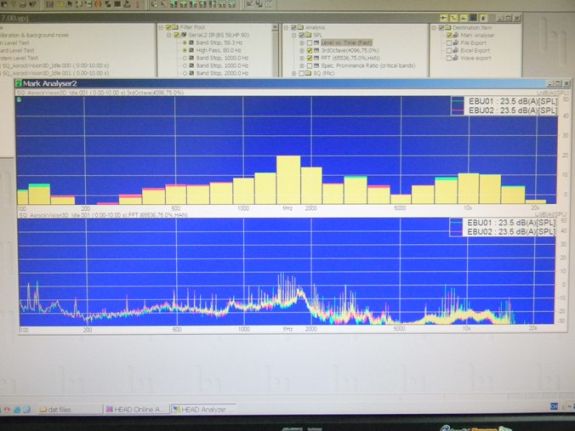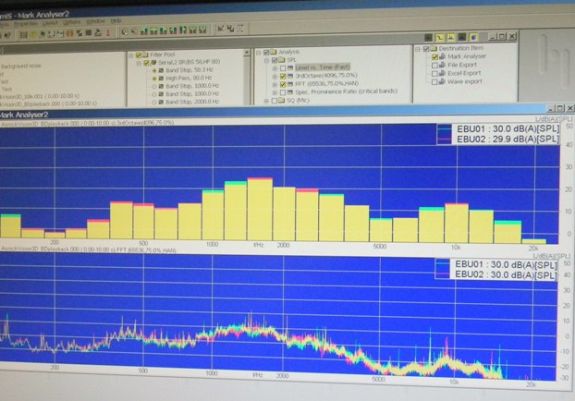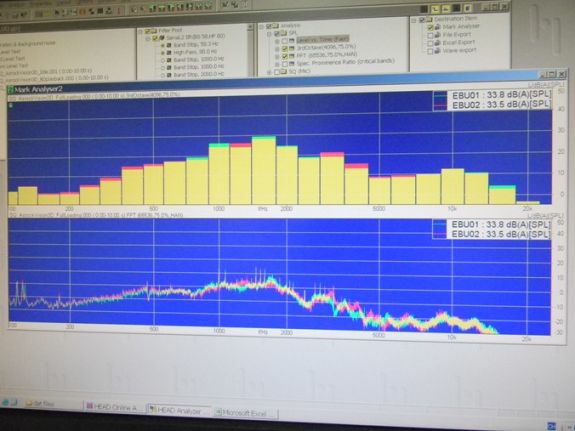ASRock's High-End Vision 3D HTPC Reviewed
by Ganesh T S on October 3, 2010 10:20 AM EST
HTPC enthusiasts are rightly concerned about the noise factor, heat and power consumption, ease of usage and many other criteria. We will tackle each of these concerns one by one in this section.
Noise
ASRock doesn't make any claims about the quietness of the system in their marketing material. We were pleasantly surprised upon looking at the noise reports. In the set of pictures below, a professional sound level detector was placed 2 ft away from the Vision 3D, and the sound level measurements were taken in various HTPC scenarios. The unit has a noise level of less than 35 dB at full load (for both CPU and GPU). In this respect, it is actually similar in performance to the Core 100. In fact, it is slightly better because of the elimination of one of the fans.
23.6 dB at Multimedia File Playback
33.8 dB at Full Load (Prime95 + Furmark)
Power Consumption
In order to get an idea of the power consumption numbers, the Prime95 and Furmark benchmarks were let run overnight to keep both the CPU and GPU completely loaded for an extended duration. Under these extreme conditions, we found the average power consumption to be around 82 W. At idle, the average power consumption was around 20 W.
These type of power consumption numbers have been enabled by ASRock's choice of going in for an Arrandale instead of a Clarkdale platform. This has resulted in a smaller form factor case design for the mini-ITX motherboard. Since there is not much heat to be dissipated, the cooling system is also appropriately small and silent.
Ease of Use
HTPC enthusiasts are concerned about how easy it is for their system to come out of standby. Existence of HDMI handshake issues upon return from standby is also a deal breaker for many. Fortunately, the Vision 3D has no issues in these two aspects. As long as the AC power adapter is connected to the system, the bundled MCE remote can be used to boot the system (even if the PC had been shut down previously). In order to shorten the boot times, ASRock supplies an Instant Boot utility. Using this, whenver the Vision 3D is shut down, it boots up once again and shuts down before the power can be safely removed. Upon power up, the boot up is instantaneous. If the user wants to put the PC in sleep mode, ASRock also supplies a Goodnight LED feature in the BIOS, which turns off the bright blue blinking LED in front. The MCE remote can also be used to bring the PC out of sleep mode.
Within Windows, the MCE remote can be made to work with a variety of applications such as XBMC, MediaPortal, MPC-HC and of course, Windows 7 Media Center. Blu Ray players such as PowerDVD and ArcSoft TMT can also be controlled with the help of the MCE remote. For the ideal I/O scenario, one probably needs to purchase a wireless keyboard / mouse combo.
It was seen in an earlier section that the Vision 3D happened to get a perfect score in the Anandtech Media Streamer Test Suite. The unit could playback all files using one program or the other, and people expect nothing else from a HTPC. Unfortunately, there is no single unified interface (from XBMC or MediaPortal or any other similar program) which could successfully play back all the files from within. There is definitely an ease of use issue existing here. However, this is not ASRock's fault, and will probably continue to exist on all HTPC platforms. Hopefully, projects such as XBMC's DSPlayer mature rapidly to alleviate this problem.














51 Comments
View All Comments
ganeshts - Monday, October 4, 2010 - link
Momentus XT is a hybrid and not a pure hard drive. In any case, I have already linked to a StorageReview.com comparison of the 500 GB WD Scorpio Black and the Momentus XT. There are benchmarks in which the Scorpio Black turns out better.http://www.storagereview.com/western_digital_scorp...
troystarr - Monday, October 4, 2010 - link
I'm curious how fast it can load blu-ray discs, such as the time from blu-ray disc insertion to the BD-Java main menu, speed of interacting with BD-Java menus, etc. I have a Blu-ray Profile 2.0 player that's about 2 years old now, and while it plays blu-ray discs great, it's pretty slow to load them and navigate their menus. If I try to use any Internet-based content via BD Live, it's downright painful. I would love to see comparisons in load time between this device, a typical consumer Blu-ray player, and a Sony PS3.Thanks for the review!
michael.gulde - Monday, October 4, 2010 - link
Was there a cable card for cable tv hd encrypted channels?ganeshts - Monday, October 4, 2010 - link
The ASRock Vision 3D is high end from the viewpoint of supporting the latest standards such as 3D which are yet to go mainstream.Also, the system has been designed taking the world market into consideration, and people outside the US just don't use CableCard.
You can always use the upcoming SiliconDust HD Tuners with CableCard functionality if this is something essential :)
cknobman - Monday, October 4, 2010 - link
this is just too expensive to justify for most consumers.I dont do alot of actual computing from my media room so therefore when I think HTPC I want something that can access my network and stream content and play games.
Those things can be done by already existing equipment in my house or even other new equipment for much cheaper.
PS3 - $299
Xbox 360 - $299
Blu Ray player - > $200
Media Streamer - $50 - $150
True this impressive little unit is also a full blown computer but as someone with 4 other pc's in the house already I dont really need a full blown computer as part of my media room.
I think this would be perfect for someone who dosnt really own a gaming system and/or blue ray player already and would like an all-in-one solution.
Otherwise I think that is really is priced too high to be of any real value to most consumers.
vlado08 - Monday, October 4, 2010 - link
Hi Ganesh, thanks for the good article. I have several questions.1 What was the HDD tems when the GPU was under load? Because the HDD is sitting above the GPU I have some concerns.
2 What does the DPC Latency Checker shows? Are there any latency problems? In the sreen shot of the MPC-HT there are some spikes in the green line?
3 Do we need to disable Intel speed step for latensy free playback?
4 Is it possible to put a HDD vertically mounted to the side wall of the Vision 3D? This way you can have 3 HDD inside - two on the side and one under the DVD/Blu-ray.
ganeshts - Monday, October 4, 2010 - link
1. I never received warnings about HDD temperature when running Furmark. The only time there was a warning was when I was copying around 100 GB of data from the USB 3 port (so much higher write rate than even through GbE network) into internal hard disk, at which point the temperature reached 52 C towards the very end. As long as you are doing normal HTPC activities, I don't think this will be an issue.2/3. I did DPC latency checks for the Core 100, but found no issues with playback even though the checker reported issues. I have come to the conclusion (with help of other editors here at AnandTech), that there is no necessity that there is an issue even if the checker reports it. In all, even though I saw the spikes in MPC-HC, I didn't notice any issues in the playback of Blu-Rays or any of our other test streams, even with SpeedStep enabled.
4. No, there is no space for any more components within the Vision 3D chassis :(
vlado08 - Monday, October 4, 2010 - link
Thanks again for the quick reply and for your enthusiasm.junkles - Monday, October 4, 2010 - link
Hi, Ganesh.So which HTPC functions have you found to be lacking with a Linux distribution such as Ubuntu?
Thanks
ganeshts - Monday, October 4, 2010 - link
For starters, Blu-Ray disc playback and HD audio bitstreaming (even for stand alone files)I just wish we had a Linux program capable of playing back Blu-Rays (particularly considering the fact that all standalone BR players run some version of Linux at the core).